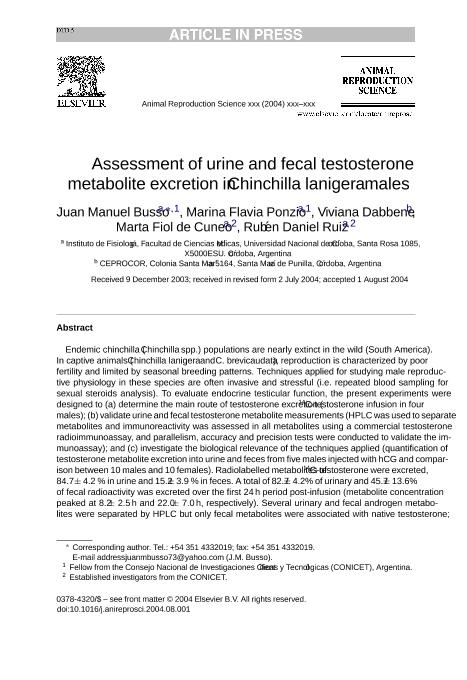Artículo
Assessment of urine and fecal testosterone metabolite excretion in Chinchilla lanigera males
Busso, Juan Manuel ; Ponzio, Marina Flavia
; Ponzio, Marina Flavia ; Dabbene, Viviana; Fiol, Marta Haydee
; Dabbene, Viviana; Fiol, Marta Haydee ; Ruiz, Ruben Daniel
; Ruiz, Ruben Daniel
 ; Ponzio, Marina Flavia
; Ponzio, Marina Flavia ; Dabbene, Viviana; Fiol, Marta Haydee
; Dabbene, Viviana; Fiol, Marta Haydee ; Ruiz, Ruben Daniel
; Ruiz, Ruben Daniel
Fecha de publicación:
12/2005
Editorial:
Elsevier Science
Revista:
Animal Reproduction Science
ISSN:
0378-4320
Idioma:
Inglés
Tipo de recurso:
Artículo publicado
Clasificación temática:
Resumen
Endemic chinchilla (Chinchilla spp.) populations are nearly extinct in the wild (South America). In captive animals (Chinchilla lanigera and C. brevicaudata), reproduction is characterized by poor fertility and limited by seasonal breeding patterns. Techniques applied for studying male reproductive physiology in these species are often invasive and stressful (i.e. repeated blood sampling for sexual steroids analysis). To evaluate endocrine testicular function, the present experiments were designed to (a) determine the main route of testosterone excretion (14C-testosterone infusion in four males); (b) validate urine and fecal testosterone metabolite measurements (HPLC was used to separate metabolites and immunoreactivity was assessed in all metabolites using a commercial testosterone radioimmunoassay, and parallelism, accuracy and precision tests were conducted to validate the immunoassay); and (c) investigate the biological relevance of the techniques applied (quantification of testosterone metabolite excretion into urine and feces from five males injected with hCG and comparison between 10 males and 10 females). Radiolabelled metabolites of 14C-testosterone were excreted, 84.7 ± 4.2 % in urine and 15.2 ± 3.9 % in feces. A total of 82.7 ± 4.2% of urinary and 45.7 ± 13.6% of fecal radioactivity was excreted over the first 24 h period post-infusion (metabolite concentration peaked at 8.2 ± 2.5 h and 22.0 ± 7.0 h, respectively). Several urinary and fecal androgen metabolites were separated by HPLC but only fecal metabolites were associated with native testosterone; however, there was immunoreactivity in more than one metabolite derived from 14C-testosterone. After hCG administration, an increase in androgen metabolite excretion was observed (p < 0.05). Males excreted greater amounts daily of urinary androgen metabolites as compared with females (p < 0.05); this difference was not evident in feces. Results of the present study indicate that the procedure used is a reliable and non-invasive method to repeatedly monitor variations in testicular endocrine activity in this species. It can be a useful tool that would help ensure the survival of the wild populations as well as to provide the basis for a more efficient use by the fur industry.
Archivos asociados
Licencia
Identificadores
Colecciones
Articulos(CCT - CORDOBA)
Articulos de CTRO.CIENTIFICO TECNOL.CONICET - CORDOBA
Articulos de CTRO.CIENTIFICO TECNOL.CONICET - CORDOBA
Articulos(INICSA)
Articulos de INSTITUTO DE INVESTIGACIONES EN CIENCIAS DE LA SALUD
Articulos de INSTITUTO DE INVESTIGACIONES EN CIENCIAS DE LA SALUD
Citación
Busso, Juan Manuel; Ponzio, Marina Flavia; Dabbene, Viviana; Fiol, Marta Haydee; Ruiz, Ruben Daniel; Assessment of urine and fecal testosterone metabolite excretion in Chinchilla lanigera males; Elsevier Science; Animal Reproduction Science; 86; 3-4; 12-2005; 339-351
Compartir
Altmétricas



